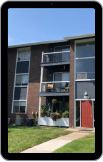Recession-resilient real estate has long been considered an optimal way to generate financial freedom for yourself and create generational wealth while mitigating risk, but how do you define “recession-resilient”, and is all real estate considered recession-resilient?
While it’s true that all asset classes move in cycles with corresponding peaks and valleys, including real estate, not all real estate is equally affected by recessions. Recession-resilient real estate refers to assets that are able to withstand economic downturns and maintain their value and/or generate revenue during periods of economic distress.
Historical trends show us that real estate generally experiences less volatility and holds its value better than stocks, cryptocurrencies, private equity, etc., considering their prices can drop to zero. The chart below by CoStar shows the performance of commercial real estate compared to the stock market and REITs as we entered the downturn.

Another fundamental factor of real estate holding its value is that it is a tangible asset. Brick and mortar, strategically located, creates lasting value as infrastructure is necessary for communities.
Understanding that real estate generally holds its value stronger than other investment vehicles during a recession sets the foundation for understanding specific real estate sectors that historical data has shown to perform the strongest. Let’s dive deeper into these asset classes.
One of the primary markers of a recession-resilient asset is being able to generate positive cash flow. This is not only because of the consistent and predictable cash flow but because this cash flow helps ensure that the debt service can be maintained (effectively avoiding the largest risk in real estate investing – defaulting on the debt service and losing control of the asset).
Here at Axia Partners, we focus on four specific cash-flowing asset types:
Multifamily: Shelter is a primary human need. People will always need a place to live, making affordable living a necessity, not a commodity. Multifamily also benefits from having longer lease agreements (typically 12 months), which helps maintain occupancy levels and create consistent revenue regardless of macroeconomic cycles.
Because recessions erode consumer confidence and increase risk aversion, many households in a place to buy homes hold off until conditions feel less risky. Historically, those in apartments stay put or downgrade to Class B or C asset classes. The chart below by Costar shows multifamily vacancy over the past two years, indicating stable demand for Class B and C units.

According to a study by the National Association of Realtors, multifamily apartments experienced an average decline in value of just 2.3%, compared to a decline of almost 30% for single-family homes during the 2008-2009 recession.
Self-Storage: Americans are consumers! This is especially true during favorable economic times, causing consumers to need extra space to store valuables. On the flip side, self-storage has also performed very well during the worst times. During downturns, people need to downsize their homes or businesses but don’t want to part from their belongings, leading to increased demand for storage facilities to store excess belongings. According to a study by the Self Storage Association, self-storage properties experienced an average decline in value of just 0.5% during the 2008 recession.
RV Parks: The demand for RV parks is less sensitive to economic downturns as people are looking for more affordable vacation options as consumers focus on affordability. During the pandemic, RV parks were booked to capacity across the country, with people seeking experiential travel on a budget.
Because RVs are also considered high-ticket investments, consumers want to get the most out of their investments. During the pandemic, Cheryl Smith of The National Association of RV Parks and Campgrounds reported, “We have lots of RV parks where occupancy rates are up 13 to 14% with the U.S. national increase averaging out at nearer 5%.”
Lastly, RVX, the RV Experience, found that the number of people who identify as full-time RVers has increased by nearly 50% over the past decade, with more than one million Americans now living in RVs full-time. This makes RV parks move the necessity sector as those claiming it as their full-time home grows.
Industrial: Industrial is expected to be one of the top-performing real estate classes due to demand to move and store essential goods. We consider industrial warehouses as recession resilient for several other reasons as well, including:
- In general, having longer-term leases
- Historical trends of low vacancy rates
- Historical trends of low vacancy rates
And perhaps most important is the continued shift to E-commerce business – a trend that we believe will continue to expand.
According to a study by the National Association of Industrial and Office Properties, industrial properties experienced an average decline in value of just 0.8% during the last recession.
All four asset types provide essential services and have historically shown a powerful resiliency during recessionary environments. We at Axia Partners focus on these asset types because our highest priority is always, first and foremost, protecting investor capital, followed by generating strong returns on capital.
Most people fear recessionary environments. However, for those that are prepared and willing to embrace change with nimbleness, recessions can be a lucrative time to buy assets at a steep discount. While no one can predict the future in these volatile times, I’m confident that smart disciplined investors focused on recession resilient cash flowing asset classes will come out on top.

